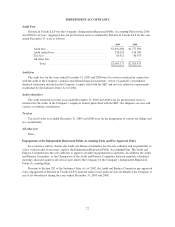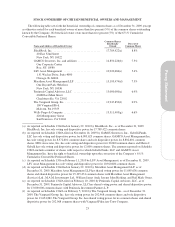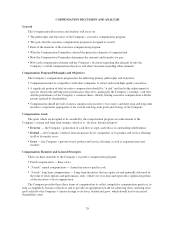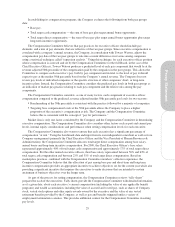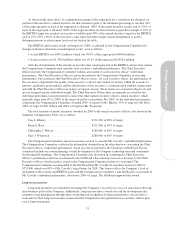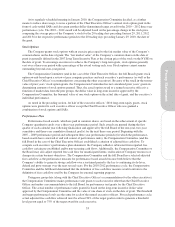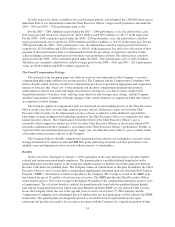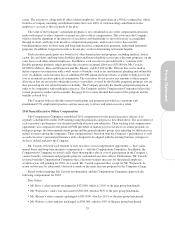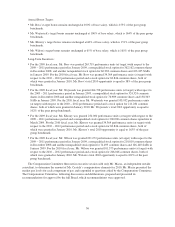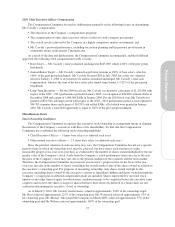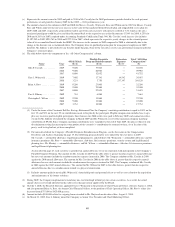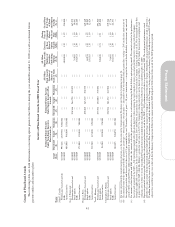Cincinnati Bell 2009 Annual Report Download - page 45
Download and view the complete annual report
Please find page 45 of the 2009 Cincinnati Bell annual report below. You can navigate through the pages in the report by either clicking on the pages listed below, or by using the keyword search tool below to find specific information within the annual report.
As shown in the chart above, if a minimum percentage of the target goal for a criterion is not obtained, no
portion of the executive’s annual incentive for that criterion is paid; if the minimum percentage is reached, 50%
of the target incentive is paid; if the target goal is obtained, 100% of the target incentive is paid; and, if 120% or
more of the target goal is obtained, 200% of the target incentive for that criterion is paid. For example, if 95% of
the EBITDA target was reached, an executive would be paid 50% of the annual incentive target for the EBITDA
goal or 25% (50% x 50%) of the executive’s total annual incentive target. Linear interpolation is used to
determine payouts at achievement levels not set forth in the table.
The EBITDA and revenue results and targets for 2009, as adjusted by the Compensation Committee for
changes in business direction or unanticipated events, were as follows:
•Actual EBITDA was $470.2 million, which was 98.0% of the target goal of $480.0 million.
•Actual revenue was $1,336.0 million, which was 94.1% of the target goal $1,420.0 million.
After the determination of the amount an executive has earned pursuant to the EBITDA and revenue criteria,
the Compensation Committee then considers that executive’s individual performance. The Chief Executive
Officer provides the Compensation Committee with his assessment of each executive officer’s individual
performance. The Chief Executive Officer is given discretion by the Compensation Committee in assessing
performance, but, in general, the Chief Executive Officer reviews, for each executive officer, the performance of
the executive’s department, the quality of the executive’s advice and counsel on matters within the executive’s
purview, qualitative peer feedback and the effectiveness of the executive’s communication with the organization
and with the Chief Executive Officer on matters of topical concern. These factors are evaluated subjectively and
are not assigned specific individual weight. The Chief Executive Officer then recommends an award for the
individual performance-based portion for each of the other named executive officer’s annual incentive, which
generally range from 0% to 200% of the target award for such portion. For 2009, for the individual performance
component, the Compensation Committee awarded 200% of target for Ms. Khoury, 50% of target for Mr. Ross,
200% of target for Mr. Wilson and 200% of target for Mr. Wojtaszek.
The total amounts of annual incentives awarded for 2009 to the named executive officers, also shown in the
Summary Compensation Table, are as follows:
Tara L. Khoury ............................. $151,200, or 80% of target
Brian A. Ross .............................. $212,500, or 50% of target
Christopher J. Wilson ........................ $160,680, or 80% of target
Gary J. Wojtaszek .......................... $280,000, or 80% of target
The Compensation Committee meets in executive session to consider Mr. Cassidy’s individual performance.
The Compensation Committee evaluates the information obtained from the other directors concerning the Chief
Executive Officer’s individual performance, based on a discussion led by the Chairman of the Board. Factors
considered include succession planning, overall development of the Company leadership team and community
involvement/relationships. The Compensation Committee has discretion in evaluating the Chief Executive
Officer’s performance and may recommend to the full Board a discretionary increase or decrease to the Chief
Executive Officer’s final incentive award as the Compensation Committee believes is warranted. The
Compensation Committee recommended to the full Board that Mr. Cassidy be awarded a bonus for 2009 of
$774,400, which was 80% of Mr. Cassidy’s target bonus for 2009. This bonus reflects the Company’s level of
attainment of the revenue and EBITDA goals and the Compensation Committee’s and full Board’s assessment of
Mr. Cassidy’s individual performance, which was 200% of target. The full Board approved the award.
Long-term incentives
Long-term incentives are intended to encourage the Company’s executives to focus on and achieve the long-
term business goals of the Company. Additionally, long-term incentive awards also aid the development and
retention of top management through share ownership and recognition of future performance. An executive’s
realization of their long-term incentive means that the Company has also performed in accordance with its plan
over a long-term period.
31
Proxy Statement



